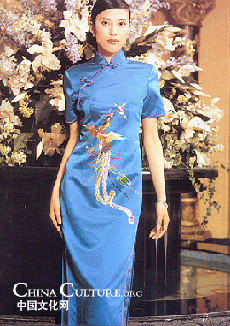|
The cheongsam, or Qipao in Chinese, is evolved from a kind of ancient clothing of Manchu ethnic minority. In ancient times, it generally referred to long gowns worn by the people of Manchuria, Mongolia and the Eight-Banner.

In the early years of the Qing Dynasty (1644-1911), long gowns featured collarless, narrow cuff in the shape of a horse's hoof, buttons down the left front, four slits and a fitting waist. Wearers usually coiled up their cuff, and put it down when hunting or battling to cover the back of hand. In winter, the cuff could serve to prevent cold. The gown had four slits, with one on the left, right, front and back, which reached the knees. It was fitted to the body and rather warm. Fastened with a waistband, the long gown could hold solid food and utensils when people went out hunting. Men's long gowns were mostly blue, gray or green; and women's, white.
Another feature of Manchu cheongsam was that people generally wore it plus a waistcoat that was either with buttons down the front, a twisted front, or a front in the shape of lute, etc.
 
When the early Manchu rulers came to China proper, they moved their capital to Beijing and cheongsam began to spread in the Central Plains. The Qing Dynasty unified China, and unified the nationwide costume as well. At that time, men wore a long gown and a mandarin jacket over the gown, while women wore cheongsam. Although the 1911 Revolution toppled the rule of the Qing (Manchu) Dynasty, the female dress survived the political change and, with succeeding improvements, has become the traditional dress for Chinese women.
|



